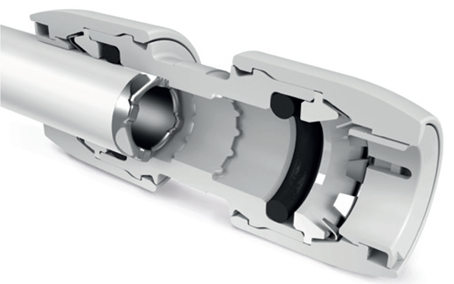Push-fit plumbing is a fantastic alternative to traditional plumbing fittings. In this blog, we’ll look closely at how the system has evolved since it first launched, and we’ll uncover its many benefits. But first, let’s start by exploring what we mean by push-fit plumbing.
What is push-fit plumbing?
Push-fit plumbing is a quick and easy way to replace and repair plumbing installations in any home. The revolutionary plastic push-fit fittings and pipes replace traditional plumbing fittings, making things much simpler for the installer.
The history of push-fit plumbing
Plastic push-fit plumbing systems were introduced to the UK in the 1970s by us. In fact, we were the first company to design and manufacture the first-ever push-fit system.
Known as Acorn, this plastic push-fit system was developed for installers. Using plastic pipe was a cost-effective alternative to copper – the only material available for plumbers until this point.
The introduction of this system sparked a true revolution in the industry and dramatically changed how plumbers did their job.
In 1991, HepO was introduced to the market. This easy-to-install push-fit system featured demountable joints, greatly simplifying the process for plumbers.
Almost two decades after its launch, HepO was redesigned – based on feedback from thousands of plumbers – to incorporate a number of new features.
Throughout the years, the tried and trusted plastic push-fit product has evolved dramatically and today is recognised as the professional system of choice.
What are the benefits of a Hep2O plastic push-fit plumbing?HepO is the most technologically advanced fitting on the market and has many unique features and benefits.
Installation benefitsInstallation is quick and easy with HepO.
The push-fit pipes are incredibly flexible which means not only can they be cabled around obstructions, but the straight coil technology means when its uncoiled, the pipe remains straight – which is perfect for fitting into tight spaces.
As a push-fit system, HepO is a much safer system to install as no soldering is required. Therefore, no flames are needed on site helping to lower the overall risk during installation.
Another key benefit of this system is that HepO also offers incredible joint security.
Performance benefitsCompared to traditional rigid metal plumbing systems, the plastic push-fit pipe is resistant to corrosion and scale build-up. Plus, the incredible design means the pipes are highly resistant to impact meaning they are unlikely to move or bend.
The push-fit system also includes a host of benefits that will no doubt appeal to homeowners. For instance, as the plastic push-fit pipes and fittings create water-tight seals they massively reduce the risk of faults within the system including leaks and burst pipes. The streamlined white design also offers a more attractive, sleek and contemporary system, compared to copper alternatives.
Additionally, once the system is up and running, it’s incredibly quiet and smooth. Made from polybutylene plastic, the pipes are also cool to the touch making them much safer for homeowners.

In4sure joint technology
Another benefit of HepO is that every fitting uses In4Sure join recognition technology.
The system has been specially designed to give installers complete peace of mind so they know the joint is properly connected and has formed a water-tight seal on all pipes.
This procedure is incredibly easy to follow. Simply insert the pipe, push twist and feel for the rumble as the two profiles surfaces come into contact with one another.
Can you use Hep2O plastic push-fit pipe on copper pipe?
The simple answer is yes. If required, HepO can be connected to an existing copper pipe and can be used in conjunction with copper.
The push-fit fittings have been specially designed to create reliable joints with metric copper pipe which fits to BS EN 1057 – R250.
It is also possible to fit 10 mm BS EN 1057 – R220 copper pipe into HepO fittings. However, as R220 pipe is much softer, more care needs to be taken when connecting because it can easily become misshapen or dented.
Demounting push-fit pipes
Unlike traditional plumbing fittings and pipes, demounting parts of a push-fit pipe system is much simpler to do.
In fact, there are several different types of demounting tools available which make the process of detaching HepO a lot quicker and easier. It also makes the entire system tamper proof – as only these specific tools can be used to release the pipe.
HepKey
HepKey frees the pipe by being clipped around the pipe and being held against the fitting.
The small versatile product can perfectly fit into a pocket making it a must-have tool for many plumbers.

HepKey PlusHepKey Plus is slightly larger in size. It clips onto the fitting and holds the grab ring open so the connection can be pulled apart.
Push-fit plumbing is professional system of choice in UK
In summary, push-fit plumbing is a simple and cost-effective way to install plumbing systems and there's an endless list of reasons why it's a great alternative to traditional systems. Some of its main benefits include:
HepO is suitable for all types of piping and fixtures in a home’s plumbing system. As the slimmest push-fit on the market, it can be used to help repair or replace existing systems, even in the smallest spaces.
For more than 30 years the system has delivered exceptional performance and is known as the professional system of choice.
Suitable for a range of installations, there’s a wide range of push-fit pipes and fittings available in sizes 10, 15, 22 and 28mm.
To give installers additional peace of mind, we also offer a unique 50-year guarantee which is the longest in the industry for push-fit products.
To find out more about the HepO range, click here.



